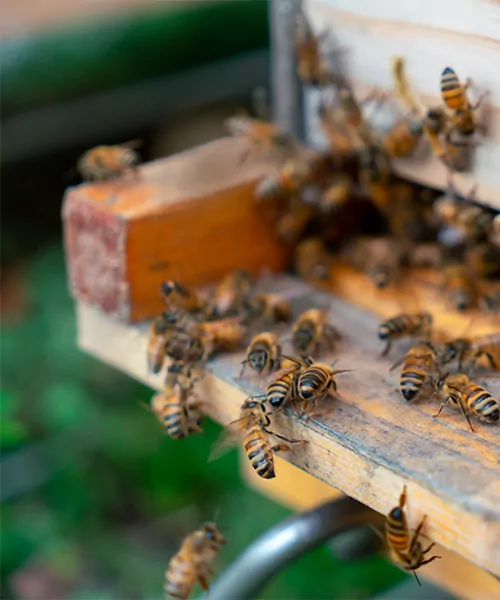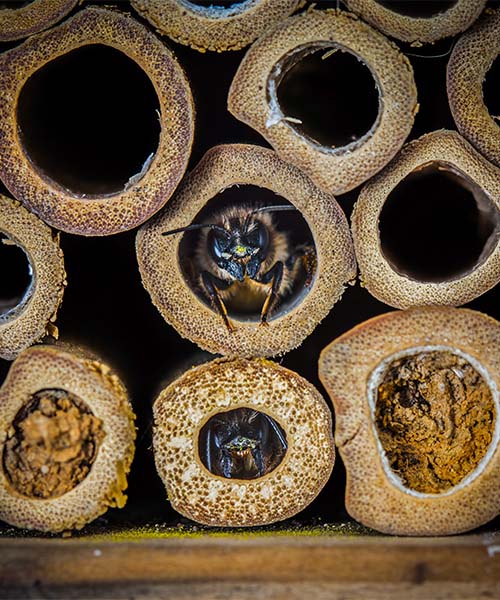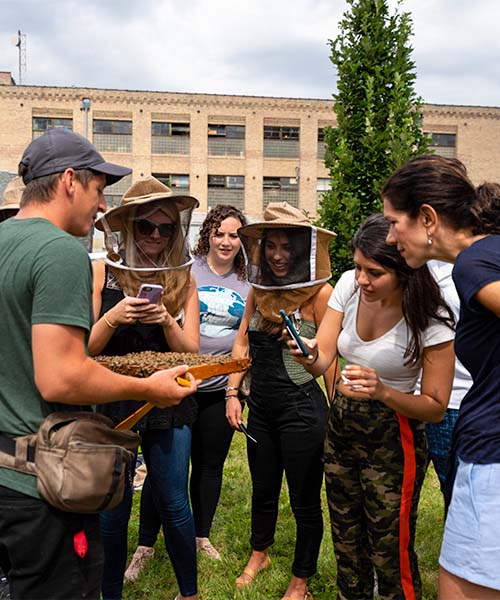What it really means to “save the bees”
“Save the bees” pops up everywhere, from t-shirts, to mugs, and even bee-shaped garden decorations. The phrase first appeared in the early 2000s, amidst news of devastating honey bee colony losses in North America. Since then, it has become a mantra for those who are moved by the plight of pollinators.
It’s a succinct sentiment that the masses can get behind, and the slogan has become inextricably linked with the bee-wakening of the past 20 years.
While “save the bees” has served as an important rallying cry for the movement to protect our pollinators, you may be surprised that you won’t hear us using it at Alvéole. While we wholeheartedly support saving bee populations, we have to question the use of this perhaps too-simple-slogan in the realm of urban beekeeping.
WHICH BEES NEED SAVING?
An important question to ask is “which bees need saving?”. The world is rich with pollinators, and while nearly all are facing unprecedented struggles leading to a global pollinator crisis, the form and severity of their threats vary, and so do the solutions.
Did you know that our planet is home to over 20,000 species of bee? Each species is incredible in their own way and plays a vital role in their native ecosystem. Some of these bees exist only in small numbers in tiny pockets of our globe, whereas others are found in large numbers over widespread areas, and are likely more present in your life than you realize.
-

-
HONEY BEES ARE ONLY PART OF THE STORY
The European honey bee (the species you’ll find occupying beekeepers’ hives, including ours), is just one of the 20,000 bee species on our planet, though they get the vast majority of the attention.
Honey bees stand apart from other insects due to their ability to produce large quantities of honey, while also having the ability to be managed as massive, social, and easy-to-domesticate colonies. Most other bees live solitary or semi-social lives, building individual, inconspicuous nests for their offspring in hollow plant stems or tunnels underground, and will barely interact with other bees during their several-week-long lifespan.
Honey bees, in contrast, live in ever-growing colonies of thousands and are happy to tirelessly visit a wide range of flowers, making them excellent collaborators in the pollination of our food crops. Without them, our current food systems would crumble.
-

-
THE PLIGHT OF THE WILD BEE
With such different realities, it’s only natural that honey bees and wild bees are facing different struggles. For most wild bee species, the effects of climate change and habitat loss are the major factors in population decline. For some remote bee species, climate change is quickly impacting the fragile ecosystems they live in, which are home to flora and fauna that require very specific conditions to survive.
Over the past several centuries, invasive plant species have steadily overrun the native flora of countless regions of our world. This causes habitat loss for the pollinators who rely on those native species for food and nesting.
The transformation of our wild landscapes for food production and urbanization has been another major cause of habitat loss. Sprawling stretches of diverse floral species and natural pollinator habitat have been transformed into monoculture crops that produce lots of human food, but little nectar and pollen, and which often rely on significant pesticide use. Once-wild spaces have also been transformed into urban areas, with little consideration for the habitat of the area’s pollinators.
It’s no wonder our wild bees have been struggling!
HONEY BEES HAVE THEIR OWN STRUGGLES
Honey bees, meanwhile, have seen their own set of issues – particularly over the past 40 years. Thanks to their resourceful, adaptable nature and their domestication by humans who are able to supplement their feed, honey bees haven’t been as affected by habitat loss, but rather by a combination of other factors.
The epidemic that sparked the “save the bees” movement and catapulted into the media began in the 1990s, but really reared its head in the early 2000s. North American beekeepers started to report unprecedented colony loss and were seeing symptoms in their colonies that were never before recorded.
For starters, honey bees were being affected by the explosion of the destructive varroa mite. Originating in Asia, it feeds off both developing and adult honey bees, often transmitting disease to them, and can be passed from one bee to another while foraging flowers. Honey bees also felt the effects of pesticide use on the crops they were pollinating. In particular neonicotinoids, which had recently been introduced with abandon in our industrial monocultures.
As if that weren’t enough, colonies in these rural areas were already suffering from depleted immune systems due to the lack of a diverse diet while foraging in monocultures, and the strain of being transported long distances from one crop to another.
All of these factors, among others, were compounded into what was coined “colony collapse disorder”.
When inspecting their colonies – which had been booming just weeks before – beekeepers were finding hive boxes either filled with the dead bodies of worker bees… or with hardly any trace of their colonies at all.
It was this never-before-seen combination of factors that propelled heart-broken beekeepers to the streets, armed with picket signs and bags of worker bees’ bodies – a metaphor to illustrate their losses- protesting pesticide-use and pleading for regulation to help save the bees. Efforts which succeeded in several cases in the banning of pesticides, to the benefit of all pollinators.
A COMPLICATED SOLUTION TO A COMPLICATED PROBLEM
The issues caused by our food and urban growth systems are vast and complex. Therefore, an equally complex solution is needed.
A true commitment to saving the bees needs to involve more robust agricultural regulation surrounding pesticide use and a reform in the way we grow our food, moving away from destructive monocultures. The solution to saving the bees will also need to involve mindful re-landscaping of our vast urban sprawl to reflect the habitat needs of native pollinators.
And none of this can happen without passionate folks advocating for change, such as our clients who choose us and other responsible partners to take them on a journey towards mindful relandscaping of our urban environments.
-

-
WHAT ROLE CAN URBAN BEEKEEPING PLAY IN SAVING POLLINATORS?
Saving the bees is no simple task. Our planet’s food systems and natural ecosystems are becoming increasingly, often problematically, intertwined. At the same time, people living in cities are more disconnected than ever from nature and the places our food comes from. We need to rebuild that relationship and installing a honey bee hive is a great way to start.
One way that urban beekeeping can help other pollinators locally is through biomonitoring. Samples of honey and pollen from urban hives can give us an incredibly accurate picture of what floral species are around your building, which pollinator species they support, and what complementary species could be planted to improve the overall quality of the landscape.
Beyond pollinating the city’s diverse flora, we would argue that the most important role urban honey bee hives play is that of an ambassador for change. One single honey bee hive atop an urban building can reach hundreds of people. Education and outreach to your tenants can lead to positive action both locally and globally, and can increase awareness of projects that more directly preserve pollinator populations.
Though the act of installing urban honey bee hives is not a silver bullet solution in and of itself, it can be used as a meaningful first step. Our honey bees encourage city dwellers to see our urban environment and food systems through a fresh lens through our impactful educational mission. Through honey bees we can inspire people and improve urban society’s connection to nature. Here at Alvéole, we believe honey bees are great ambassadors for nature because at the end of the day, we protect what we love – and it’s pretty hard not to fall in love with bees once you get to know them.
KEEP LEARNING ABOUT POLLINATORS AND HOW TO SUPPORT THEM
All of Alvéole’s urban beekeeping packages include team building activities, encouraging you and your community to bond over bees. These activities are a powerful vehicle for environmental education and awareness, transforming participants into spokespeople for all pollinators.